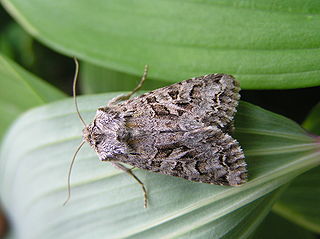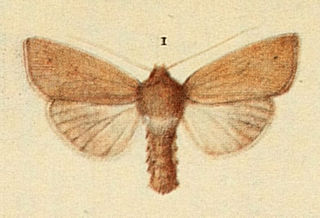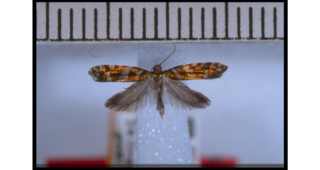Related Research Articles

Cerapteryx graminis, the antler moth, is a moth of the family Noctuidae. It is a common species throughout most of Europe but is lacking in the very dry southern regions. The northernmost occurrence is Iceland, and above the Arctic Circle. It also occurs in Siberia and in North Mongolia. The species has been introduced to North America. In the Alps it rises to an altitude of 2100 meters.

Apamea crenata, known as the clouded-bordered brindle, is a moth in the family Noctuidae. It is distributed throughout the Palearctic realm. In the North it crosses the Arctic Circle, in the Mediterranean it is found only in cool locations and mountains avoiding very hot areas. In the Alps, it rises to an altitude of about 2000 metres.

The Blastobasidae are a family of moths in the superfamily Gelechioidea. Its species can be found almost anywhere in the world, though in some places they are not native but introduced by humans. In some arrangements, these moths are included in the case-bearer family (Coleophoridae) as subfamily Blastobasinae. The Symmocidae are sometimes included in the Blastobasidae as subfamily or tribe.

Mythimna albipuncta, the white-point, is a moth of the family Noctuidae. The species was first described by Michael Denis and Ignaz Schiffermüller in 1775. It is distributed throughout Europe and one subspecies is found in Tunisia. It is also found in Asia Minor, Armenia, and Iran, and the northeastern United States.

Plemyria rubiginata, the blue-bordered carpet, is a moth of the family Geometridae found in Europe and across the Palearctic. The moth was first described by the Austrian lepidopterists Michael Denis and Ignaz Schiffermüller in 1775.

Hada plebeja, the shears, is a moth of the family Noctuidae. It is found in Europe and across the Palearctic to Asia Minor, Armenia, Turkestan, Central Asia, Mongolia, Siberia, as well as Kashmir.

Tiliacea citrago, the orange sallow, is a species of moth of the family Noctuidae. It is found in Europe as far east as the Caucasus Mountains and the Urals.

Mythimna favicolor, or Mathew's wainscot, is a moth of the family Noctuidae. The species was first described by Charles Golding Barrett in 1896. It is found in Europe. The species is sometimes treated as a subspecies of Mythimna pallens, the common wainscot.

Alabonia geoffrella is a species of gelechioid moth. Here, it is placed within the subfamily Oecophorinae of the concealer moth family (Oecophoridae). Alternatively it has been placed in the Elachistidae or Depressariinae together with its presumed closest relatives.
Tessema sensilis is a little-known moth species, the only member of genus Tessema. It belongs to the grass moth family (Crambidae), and therein to the large subfamily Spilomelinae; at the time of its description, these were still included in subfamily Pyraustinae and the entire Crambidae was then merged with the snout moths. While its detailed relationships are undetermined, it may be a close relative of Herpetogramma and/or Pilocrocis.
Nolasena is a monotypic moth genus of the family Erebidae. Its only species, Nolasena ferrifervens, is found in India, Sri Lanka, Borneo and the Philippines. Both the genus and species were first described by Francis Walker in 1858.
Asymphorodes is a gelechioid moth genus in subfamily Agonoxeninae of the palm moth family (Agonoxenidae), whose taxonomic status is disputed. Alternatively, the palm moths might be a subfamily of the grass-miner moth family (Elachistidae), with the Agonoxeninae becoming a tribe Agonoxenini.
Herlinda is a genus of cosmet moths. These moths were only discovered in 1968 and the genus was not described until 1986; its affiliations within the family are presently unknown. This genus, as far as is known, is endemic to the Marquesas Islands of Polynesia, with each species confined to a single island.

Grammodes stolida, the geometrician, is a moth of the family Erebidae. The species was first described by Johan Christian Fabricius in 1775. It is found in Africa, southern Europe, most of Asia and Australia. It migrates to central and northern Europe as far north as England, Denmark and Finland.

The silky wainscot is a moth of the family Noctuidae. It is found in most of Europe including Russia.
Epicephala spinula is a moth of the family Gracillariidae, one of the most primitive groups of ditrysian "micromoths". Within its family, it belongs to the subfamily Gracillariinae. Even though it was first scientifically studied in 1929, for many decades the specimens of this moth were mistaken for the related Australian species E. colymbetella, and their distinctness was only realized in 1986. It is found on the Marquesas Islands, where it occurs at least on Nuku Hiva, Ua Pou, and Fatu Hiva, and though little-known it is apparently not uncommon. The holotype specimen, a female, is USNM 100839.
Caloptilia insidia is a moth of the family Gracillariidae, one of the most primitive groups of ditrysian "micromoths". Within its family, it belongs to the subfamily Gracillariinae. It is apparently endemic to Fatu Hiva and Hiva Oa in the Marquesas Islands, French Polynesia. It is very similar to C. deltanthes. The species does not seem to be common, and no females appear to have been encountered yet.
Tasmantrix thula is a moth of the family Micropterigidae. It is known from eastern Australia, where it is known from northern Queensland, from Devils Thumb and Mossman Gorge in the north to Mission Beach and from Herberton State Forest to Mission beach.

Chrysorthenches argentea is a species of moth in the family Plutellidae. It was described by John S. Dugdale in 1996. It is endemic to New Zealand and has been observed in the Buller District and in the West Coast. The larval host is Manoao colensoi. Adults are on the wing in December.
References
- Clarke, John Frederick Gates (1986): Pyralidae and Microlepidoptera of the Marquesas Archipelago. Smithsonian Contributions to Zoology416: 1-485. PDF fulltext Archived 2012-03-27 at the Wayback Machine (214 MB!)